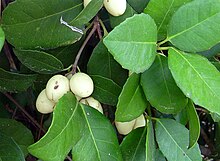| Elaeodendron | |
|---|---|
 | |
| Elaeodendron croceum | |
| Scientific classification | |
| Kingdom: | Plantae |
| Clade: | Tracheophytes |
| Clade: | Angiosperms |
| Clade: | Eudicots |
| Clade: | Rosids |
| Order: | Celastrales |
| Family: | Celastraceae |
| Genus: | Elaeodendron Jacq. |
| Species | |
See text | |
| Synonyms [1] | |
| |
Elaeodendron is a genus of flowering plants in the staff vine family, Celastraceae. It includes 40 species native to the tropics of the Americas, sub-Saharan Africa, Asia, Australia, and the South Pacific. [1] [2] [3]